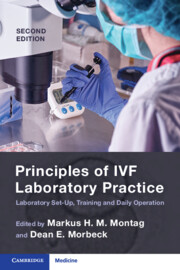Book contents
- Principles of IVF Laboratory Practice
- Principles of IVF Laboratory Practice
- Copyright page
- Contents
- Contributors
- Foreword
- The Evolution of IVF Practice
- Section 1 Starting a New Laboratory and Training Protocols
- Chapter 1 Establishing and Equipping a New IVF Laboratory
- Chapter 2 Basic Embryology Skills and Responsibilities in the IVF Laboratory
- Chapter 3 Sperm Preparation for IVF
- Chapter 4 Oocyte Pick-Up for IVF
- Chapter 5 Embryologist Training: Embryo Transfer
- Chapter 6 ICSI for IVF
- Chapter 7 Embryo Assisted Hatching for IVF
- Chapter 8 Embryo Biopsy for IVF
- Chapter 9 Vitrification for IVF
- Section 2 Pre-procedure Protocols
- Section 3 Gametes
- Section 4 Insemination/ICSI
- Section 5 Fertilization Assessment
- Section 6 Embryo Assessment: Morphology and Beyond
- Section 7 Embryo Cryopreservation
- Section 8 Embryo Transfer
- Section 9 Quality Management
- Index
- References
Chapter 8 - Embryo Biopsy for IVF
Training Protocol
from Section 1 - Starting a New Laboratory and Training Protocols
Published online by Cambridge University Press: 07 August 2023
- Principles of IVF Laboratory Practice
- Principles of IVF Laboratory Practice
- Copyright page
- Contents
- Contributors
- Foreword
- The Evolution of IVF Practice
- Section 1 Starting a New Laboratory and Training Protocols
- Chapter 1 Establishing and Equipping a New IVF Laboratory
- Chapter 2 Basic Embryology Skills and Responsibilities in the IVF Laboratory
- Chapter 3 Sperm Preparation for IVF
- Chapter 4 Oocyte Pick-Up for IVF
- Chapter 5 Embryologist Training: Embryo Transfer
- Chapter 6 ICSI for IVF
- Chapter 7 Embryo Assisted Hatching for IVF
- Chapter 8 Embryo Biopsy for IVF
- Chapter 9 Vitrification for IVF
- Section 2 Pre-procedure Protocols
- Section 3 Gametes
- Section 4 Insemination/ICSI
- Section 5 Fertilization Assessment
- Section 6 Embryo Assessment: Morphology and Beyond
- Section 7 Embryo Cryopreservation
- Section 8 Embryo Transfer
- Section 9 Quality Management
- Index
- References
Summary
Pre-implantation genetic testing for aneuploidies (PGT-A) of embryos involves confirming the chromosomal status of the embryo through assessment of biopsied cells. Most miscarriages and failed implantations are believed to be due to abnormal chromosomal status. Possessing the correct chromosome complement increases the ability of an embryo to implant and result in a live birth. Historically, biopsies occurred at the cleavage stage. However, with more cells being able to be biopsied at the blastocyst stage, representing a smaller proportion of the embryo, blastocyst biopsy is currently regarded as a safer procedure with increased sensitivity for detecting mosaics. Therefore, as the benefits of blastocyst biopsy became more evident, blastocyst biopsy has gradually become the method of choice in most in vitro fertilization (IVF) laboratories. As a technical procedure, lack of blastocyst biopsy skills has been an obstacle for some clinics to adopt this practice. This chapter outlines a structured methodology to train a biopsy practitioner to acquire the competency to confidently perform this procedure in a consistent manner that is safe for the embryos whilst maximizing the chance of pregnancy.
Keywords
- Type
- Chapter
- Information
- Principles of IVF Laboratory PracticeLaboratory Set-Up, Training and Daily Operation, pp. 54 - 64Publisher: Cambridge University PressPrint publication year: 2023



